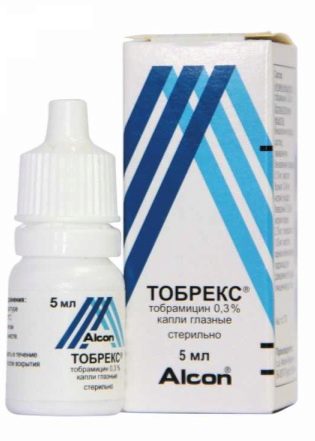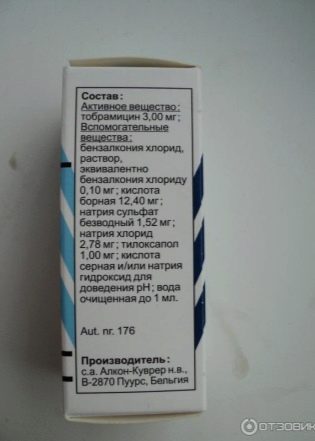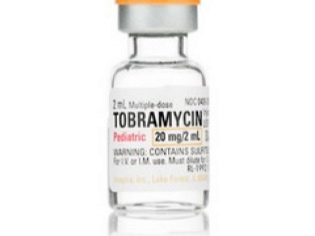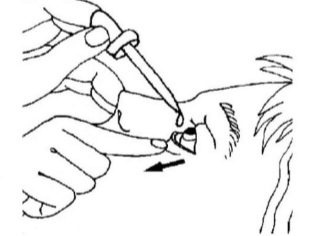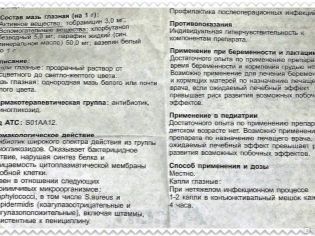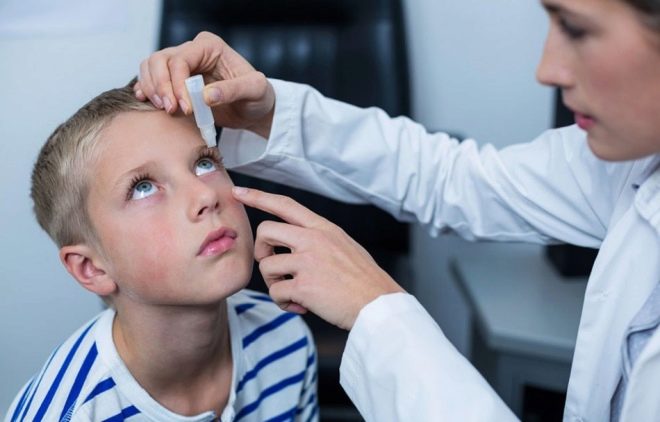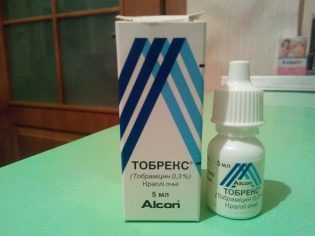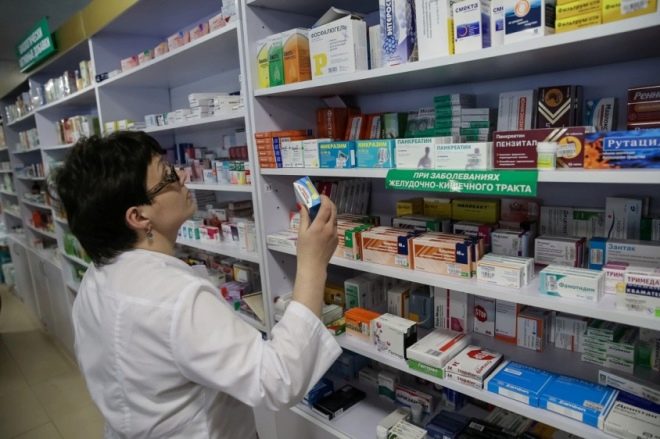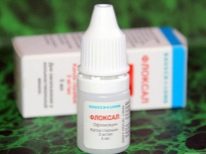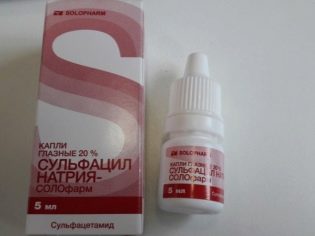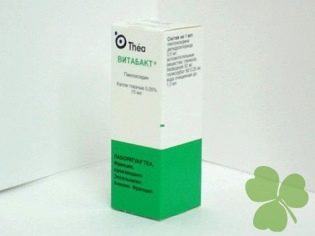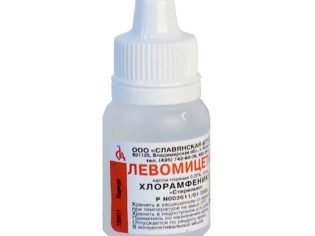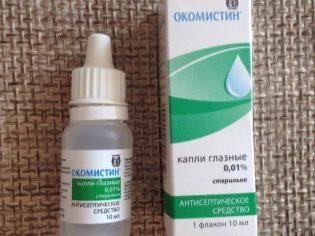Tobrex for children: instructions for use
"Tobreks" is a popular ophthalmic drug that is prescribed to both adults and children with inflammation of eye tissue caused by bacteria. It is characterized by a wide spectrum of antibacterial action, a convenient form of release and a fast therapeutic effect. Doctors and parents leave a lot of good reviews about this medicine.
Features of the drug
Tobrex is a product of Alcon, which also manufactures many other products for the ophthalmic field, for example, contact lenses, instruments for eye surgery and remedies for dry eye syndrome. At the moment, "Tobreks" is represented only by eye drops, but previously this tool was also produced in the form of ointment.
The drug is a clear solution, packaged in 5 milliliters in special bottles, droppers. It is usually colorless, but may be slightly yellow. The main ingredient of the drug is called tobramycin and is presented in a solution at a concentration of 0.3%, that is, each milliliter of the drug contains 3 mg of this antibiotic. Among the auxiliary components of "Tobreks" is sodium chloride, benzalkonium chloride, boric acid and other compounds, due to which the solution retains a liquid form and does not deteriorate.
On sale there are also drops called “Tobreks 2X”. They are also produced by Alcon and contain 0.3% tobramycin, but differ in the composition of inactive ingredients, making the solution more viscous, and its color is light brown. This medicine has mannitol, polysorbate 80, xanthan gum and other ingredients. “Tobrex 2X” is also sold in 5 ml bottle droppers and is used for the same indications.
Operating principle
Since "Tobreks" is a group of local antibiotics used in ophthalmology, it acts only on the eye tissue.
Its main ingredient belongs to aminoglycosides and has a fairly wide range of effects on pathogenic bacteria. If it is used in a small dosage, it slows down the reproduction of microbes, which helps the immune system to cope with the infection faster (this action is called bacteriostatic). At higher doses, tobramycin affects the cytoplasmic membranes in the cells of pathogens, causing their death (bactericidal effect).
In "Tobreks" note high activity in relation to such microbes that can provoke inflammation of eye tissue:
- different types of staphylococcus, including strains of epidermal and Staphylococcus aureus;
- many types of streptococci, among which are pneumococci and beta-hemolytic streptococci;
- pseudomonads, Klebsiella, Proteus, Escherichia if, hemophilus bacillus, some neisserii and other pathogens.
Indications
Most often, doctors prescribe "Tobrex" or "Tobrex 2X" to a child with conjunctivitis caused by a bacterial infection. Symptoms of this disease are usually redness of the eyes and the appearance of purulent discharge, due to which the patient does not see well, and the edges of the eyelids can stick together.
The drug is also in demand when the infection spreads from the conjunctiva to other eye tissues, for example, if the child developed blepharoconjunctivitis or the doctor diagnosed keratoconjunctivitis. Drops are prescribed for different types of blepharitis, when bacteria provoke inflammation of the eyelids, and for inflammation of the lacrimal sac, called dacryocystitis, and with meibomitis, when the glands of the eyelids are affected.
“Tobrex” is also used for keratitis, if pathogens caused inflammation of the cornea, due to which the eye became red, sore, and the surface of the cornea became dim. Another indication for the use of "Tobreks" is iridocyclitis. In it, the inflammatory process is localized in the ciliary body and the iris.
If the child has undergone surgery on the eyes, the doctor will prescribe "Tobrex" for prevention. In such cases, the task of the drops will be to prevent possible complications that provoke harmful bacteria. Some otolaryngologists recommend dripping “Tobrex” into the nose for purulent rhinitis or sinus.
How old is allowed?
The manufacturer notes the possibility of using "Tobreks" and drops "Tobreks 2X" in children older than one year. In practice, the medicine can be prescribed by ophthalmologists and pediatricians not only to children over one year old, but also to infants.
The use of drugs in the newborn is possible only by appointment of a specialist.
Contraindications
It is impossible to drip "Tobreks" only if there is hypersensitivity to any of the components of such a solution. There are no other contraindications due to the local action of such an antibiotic.
Side effects
The use of "Tobreks" can provoke in some young patients a negative local reaction caused by an allergy to the drug. It is usually manifested by swelling and severe itching, as well as tearing and redness of the eyes. The child may also complain of pain, discomfort in the eyes (as if they contain a foreign body) and a burning sensation. Any of these symptoms, which arose after the first use of the solution or after several instillations, should cause the drug to be discontinued and to go to a doctor.
Overly prolonged use of the drug can also adversely affect the patient's health. If “Tobrex” is dripped too long, the agent may cause a decrease in local immunity, which may cause the development of a fungal infection or superinfection. To reduce the risk of such complications, the drug should not be used longer than 24 days.
Instructions for use
A single dose of "Tobreks" is 1-2 drops, and the frequency of use depends on the diagnosis and the course of the disease. For example, if inflammation of the conjunctiva is light, then the medicine must be dripped into the eyes every four hours. If conjunctivitis, keratitis or another eye disease began acutely and is severe, “Tobrex” is used every hour, and as the inflammation activity subsides, the frequency decreases.
The duration of the medication is also determined individually, but most often the children are prescribed such a course of treatment for up to 7 days.
For an antibiotic to be effective, it needs to be dripped into the eyes correctly:
- before the procedure, be sure to wash your hands;
- the child should tilt his head back, and the adult should pull the eyelid of one eye down, while asking the child to look up;
- "Tobreks" need to drip into the space between the eyeball and the eyelid;
- the bottle should be held vertically above the eye;
- the tip of the bottle should not touch the eyelashes and eyelids (it is also impossible to touch it with your fingers);
- having asked the child to close an eye, it is necessary to wet the rest of the solution with a cotton disc;
- to make the drops more effective, it is recommended to keep the eye closed for 2 minutes after the instillation of the medicine, pressing it in the area of the inner corner;
- then the procedure is repeated for the second eye, if necessary;
- after each instillation the bottle should close tightly.
If the child has been prescribed “Tobrex 2X”, then before each use the bottle with such drops should be shaken. Since the agent is thicker and lasts longer on the mucous membrane of the eye, its frequency of use is less than for Tobrex.
The solution is injected into the patient's eye one drop four times on the first day, and then the agent is applied twice until the end of the course prescribed by the doctor.
Overdose
If you accidentally use "Tobreks" in a higher dose than prescribed by the doctor, you can provoke erythema, eyelid swelling, itching, severe watering of the eyes, or even pinpoint corneal inflammation.
To eliminate these symptoms, you need to cancel the medication, rinse your eyes with clean water and symptomatic therapy.
Interaction with other drugs
"Tobrex" can be administered along with any other medication, with the exception of other aminoglycoside antibiotics, which are taken orally. If to combine drops with such means, development of side effects which call system are possible.
If "Tobreks" is used together with other ophthalmologic drugs, then they should be injected into the eyes with an interval of 5 minutes. If other eye drops are prescribed with “Tobrex”, then the procedure for using drugs is not important, and when prescribed, you should first drop “Tobrex” together with the ointment, and after five minutes you can put the ointment.
Terms of sale
Both "Tobreks" and "Tobreks 2X" are sold with a prescription, therefore, a specialist's examination before purchasing such antibiotics is mandatory. The cost of one bottle is on average 180-200 rubles.
Storage conditions
The manufacturer calls the optimal temperature for “Tobreks” storage at home the range of + 8- + 30 degrees, that is, it is not necessary to keep the medicine in the refrigerator. For “Tobrex 2X”, a temperature range of +5 to +25 degrees is recommended.
The shelf life of the solution, if the package has not yet been opened, is 3 years (for “Tobrex 2x” - 2 years), but after the first use the medication can be dripped only for four weeks. If the vial was opened more than a month ago, the drug should be discarded, even if all the medicine has not been used.
Reviews
About treatment with Tobreks there are mostly positive reviews, in which parents praise such drops for the good effect on barley and conjunctivitis, a reasonable price and ease of use.
By cons of medication, some mothers include the short shelf life of the opened medication. In rare negative reviews complain about the adverse reaction or lack of effect, because of what had to again go to the doctor and change the antibiotic.
Analogs
If for any reason it is not possible to use “Tobrex” in a child, the doctor can replace such children's drops with another local antimicrobial drug, the list of which is quite long.
- «Floksal». Such drops on the basis of ofloxacin represent a group of fluoroquinolones and can be used in children with conjunctivitis and other eye infections from birth. The drug is also available in the form of ointment. Instead of "Floxal" in drops you can use "Dancil" and "Uniflox" - analogues, which also contain ofloxacin.
- «Cypromed». The effect of these eye drops on bacteria is caused by ciprofloxacin, which is also fluoroquinolone. It can be used in children older than a year. "Cipromed" is also produced in the form of ear drops, which are dripped into the ears of patients over 15 years old. Analogues of this medicine are drops "Tsiprolet"And"Ciprofloxacin».
- Torbradex. Unlike Tobreks, such drops contain not only tobramycin, but also dexamethasone. They are prescribed for keratitis, inflammation of the conjunctiva and blepharitis in children over 12 years old. The drug may be replaced by other combination medications that act by combining an antibiotic and a glucocorticoid, for example, Sofradex or Maksitrol.
- "Sulfacyl sodium". This sulfonamide drug is also called "Albucid". It is used for purulent inflammation of the eyes or for its prevention at any age, including in newborns.
- «Vitabact». Such eye drops contain pikloksidin and can be used for dacryocystitis, keratitis, blepharitis and other eye diseases from birth. Since the active component of Vitabact affects some viruses and fungi, this medicine can also be prescribed for viral conjunctivitis.
- «Levomycetin». This product contains chloramphenicol and can be used as an eye drop at any age. It is prescribed to drip when blepharitis, barley and other infectious diseases of the eye.
- «Okomistin». This remedy from the group of antiseptics acts not only on bacteria, but also on other infectious agents. It contains miramistin and can be applied from the age of three. These drops can also be administered to the nose or to the ears.
Tips from an ophthalmologist for instillation of eye drops in children are presented in the video below.

